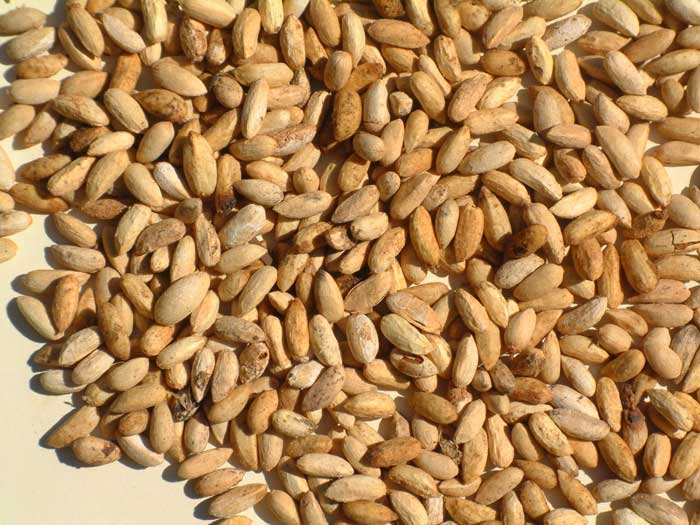
If you’re new to Neem Oil, you’re in for a wonderful treat!
This versatile oil is extracted from the cold pressed seeds of the Azadirachta indica tree.

Dried Neem Seeds
The Neem Tree is an evergreen that is part of the Mahogany botanical family called Meliaceae and can be found in dry regions of India, Southeast Asia and parts of Africa. The tree is very drought resistant.
Pay Attention to the Extraction Method
When you purchase Neem oil, make sure you get organic, cold pressed rather than oil that was obtained by solvent extraction. Solvent extraction produces a lower quality product and is primarily used in soap manufacturing.
The Elephant in the Room: The Smell
Poor Neem. Such a powerful healer but without the “selling benefit” of her cousins Jojoba, Grapeseed and Baobab. I’d describe it as slightly garlic-y.
But let’s face it, in our Febreeze-coated society where we sell products like “Fresh Twist Cranberry Air Freshener” or “Hawaiian Mystical Mountain Breeze” body lotion (made with gobs of synthetics), you can’t expect something natural like Neem oil to be embraced without a little help. I suggest you dilute it with another carrier like Sweet Almond Oil or Jojoba Wax, or simply add lovely-smelling essential oils. The citrus oils seem to work well to cover the aroma. The important thing to keep in mind is that the benefits of this powerful healer, far outweigh the funky aroma.
Neem Oil Therapeutic Properties and Benefits
Neem Oil contains an important constituent called Azadirachtin, a chemical compound that is a secondary metabolite present in neem seeds. This important component has strong anti-microbial properties and gives it good acne-fighting action. Neem oil contains fatty acids like oleic acid and linoleic acid which is one of the reasons it is deeply nourishing for the skin. Among its many wonderful properties are antibacterial, antifungal and anti-inflammatory activity making it a great choice of carrier for eczema, acne, topical fungal conditions such as athletes foot and toenail fungus. You’ll definitely want to add the essential oils of Lemongrass and Tea Tree when using it for fungal conditions. Further, Neem can be used to treat dandruff, dry, itchy scalp and restore dry, damaged hair. It is also a good treatment for head lice. It’s a great carrier when making a blend with essential oils to address wounds, cuts, scrapes, and bites. See why I like it so much?
Quick List of Neem Oil Benefits:
- Can relieve eczema and psoriasis
- Anti-microbial
- Helps with acne relief
- Is easily absorbed into the skin
- Moisturizing for both hair and damaged skin
- Improves skin tone and elasticity
- Has antifungal properties
- Can help with head lice
Eczema Healing Salve Recipe
Ingredients:
- 1 oz (28 g) Beeswax
- 1 oz (28 g) Neem Oil
- 1 oz (28 g) Tamanu Oil
- 1 oz (28 g) Calendula Infused Oil (make your own HERE)
- (2) 2 oz glass jars
- glass stir rod (these are awesome for stirring salves and lotions)
- Essential Oils (optional) You may wish to try this salve without the essential oils first. If you like it and it seems to be working, you can add the essential oils to help nourish the skin.
10 drops German Chamomile
10 drops Helichrysum
Other: - Pyrex 2-C Measuring Cup (a staple in your blending kitchen)
- Kitchen Scale (Escali is my favorite and you can get them in many colors. I have red)
- Bowls for weighing and/or storing ingredients (Oxo are my favorite!)
- Flat pan with water (or a stainless double boiler)
Directions

Step 1: Stir the beeswax in the pyrex until it’s melted
Step 2: Add the Neem and Tamanu oils and stir
Step 3: Pour into the 2 oz glass jars
Step 4: If you wish to add essential oils, do so now and stir with a glass stir rod. Cover with lid.
Where to Buy the Best Neem Oil
Below are three Organic, Cold-Pressed Neem Oil extracted without solvents. I would use any of these in my home and classroom.






